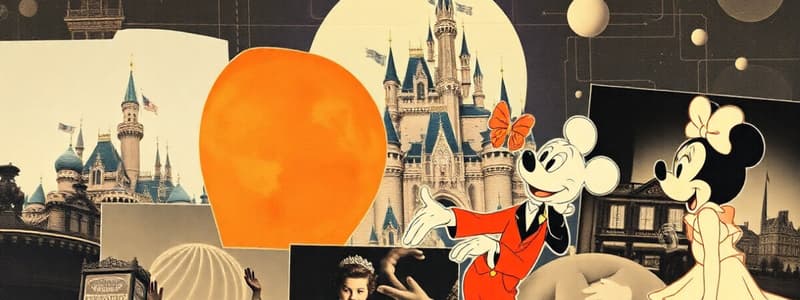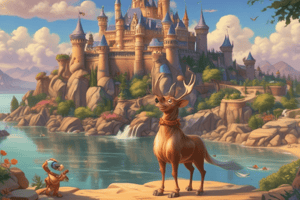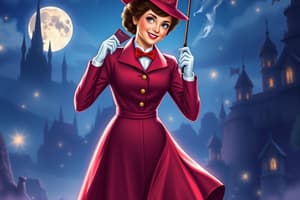Podcast
Questions and Answers
In what year was the movie 'Treasure Island' released?
In what year was the movie 'Treasure Island' released?
- 1952
- 1950 (correct)
- 1953
- 1951
What significant event related to Disneyland occurred in 1952?
What significant event related to Disneyland occurred in 1952?
- Buena Vista Distribution Co. launched
- WED Enterprises was founded (correct)
- TV specials were introduced
- The first theme park opened
What was one of the primary focuses of the TV specials in the early 1950s?
What was one of the primary focuses of the TV specials in the early 1950s?
- Adult dramas
- Reality shows
- Documentaries
- Children's programming (correct)
Which company was responsible for the distribution of films in 1953?
Which company was responsible for the distribution of films in 1953?
What genre of films was specifically mentioned in the context of 1950 and 1951?
What genre of films was specifically mentioned in the context of 1950 and 1951?
What was Disney’s first TV special that reached 20 million viewers?
What was Disney’s first TV special that reached 20 million viewers?
In what year did Disney release Treasure Island, marking its entry into live-action film production?
In what year did Disney release Treasure Island, marking its entry into live-action film production?
Which animated film was released by Disney in 1961?
Which animated film was released by Disney in 1961?
What percentage of the total U.S. box office did Disney Studios hold by 1988?
What percentage of the total U.S. box office did Disney Studios hold by 1988?
How many movies out of Disney's next 33 were profitable after Eisner's arrival?
How many movies out of Disney's next 33 were profitable after Eisner's arrival?
What was the purpose of creating Buena Vista Distribution in 1953?
What was the purpose of creating Buena Vista Distribution in 1953?
Which was the first R-rated movie released by Touchstone?
Which was the first R-rated movie released by Touchstone?
Which of the following shows followed Disneyland in 1955 as a television program featuring young hosts?
Which of the following shows followed Disneyland in 1955 as a television program featuring young hosts?
What was the primary goal of Walt Disney in creating Disneyland?
What was the primary goal of Walt Disney in creating Disneyland?
What was the primary focus of releases under the Touchstone label?
What was the primary focus of releases under the Touchstone label?
What was a characteristic of Katzenberg's approach to film production at Disney?
What was a characteristic of Katzenberg's approach to film production at Disney?
What was a major financial risk Walt Disney took when building Disneyland?
What was a major financial risk Walt Disney took when building Disneyland?
How many new films did Disney begin releasing per year after Eisner's leadership compared to 1984?
How many new films did Disney begin releasing per year after Eisner's leadership compared to 1984?
What strategy did Disney use to avoid paying high salaries in film production?
What strategy did Disney use to avoid paying high salaries in film production?
What was Eisner's perspective on Disney's live-action movies at the time he took over?
What was Eisner's perspective on Disney's live-action movies at the time he took over?
What was the estimated percentage of movies that lost money in the industry during the time of Disney's resurgence?
What was the estimated percentage of movies that lost money in the industry during the time of Disney's resurgence?
What was the annual total return to shareholders generated by Disney during Michael Eisner's tenure from 1984 to 2000?
What was the annual total return to shareholders generated by Disney during Michael Eisner's tenure from 1984 to 2000?
Which statement best describes Michael Eisner's approach to management?
Which statement best describes Michael Eisner's approach to management?
What significant event in 1996 contributed to the decline in Disney's return on equity?
What significant event in 1996 contributed to the decline in Disney's return on equity?
Which show was credited with leading the turnaround at ABC in 2000?
Which show was credited with leading the turnaround at ABC in 2000?
How much did Disney's revenues increase from 1984 to 2000?
How much did Disney's revenues increase from 1984 to 2000?
What was a consequence of Disney's heavy investments in new enterprises by the late 1990s?
What was a consequence of Disney's heavy investments in new enterprises by the late 1990s?
What challenge did Disney face by the end of the 1990s regarding its performance?
What challenge did Disney face by the end of the 1990s regarding its performance?
What was a key factor in the initial success of Disney under Michael Eisner?
What was a key factor in the initial success of Disney under Michael Eisner?
What was one result of the strategic planning unit established at Disney?
What was one result of the strategic planning unit established at Disney?
What was a common sentiment expressed by departing executives regarding Disney’s culture during Eisner's management?
What was a common sentiment expressed by departing executives regarding Disney’s culture during Eisner's management?
What did Eisner claim about the turnover of high-level executives at Disney?
What did Eisner claim about the turnover of high-level executives at Disney?
How did the strategic planning unit impact the meetings at Disney?
How did the strategic planning unit impact the meetings at Disney?
What factor led to the departure of approximately 75 high-level executives from Disney between 1994 and January 2000?
What factor led to the departure of approximately 75 high-level executives from Disney between 1994 and January 2000?
What was one executive's comment about having meetings with larger groups at Disney?
What was one executive's comment about having meetings with larger groups at Disney?
What significant change occurred to Disney’s employee count between Eisner's arrival and 2000?
What significant change occurred to Disney’s employee count between Eisner's arrival and 2000?
What was a concern about Disney's focus during Eisner's tenure?
What was a concern about Disney's focus during Eisner's tenure?
What was the revenue from Theme Parks and Resorts in 1990?
What was the revenue from Theme Parks and Resorts in 1990?
In which year did Studio Entertainment record the highest revenue?
In which year did Studio Entertainment record the highest revenue?
What was the operating income from Media Networks in 1995?
What was the operating income from Media Networks in 1995?
Which year saw the first reported revenue for Internet & Direct Marketing?
Which year saw the first reported revenue for Internet & Direct Marketing?
What was the total revenue in 1998?
What was the total revenue in 1998?
In which year did Consumer Products see its lowest operating income?
In which year did Consumer Products see its lowest operating income?
Which segment reported a negative operating income in 1984?
Which segment reported a negative operating income in 1984?
What was the operating income for Theme Parks and Resorts in 1996?
What was the operating income for Theme Parks and Resorts in 1996?
What was the total revenue for the year 1985?
What was the total revenue for the year 1985?
Which year had the highest operating income for Studio Entertainment?
Which year had the highest operating income for Studio Entertainment?
How much revenue did Consumer Products generate in 1992?
How much revenue did Consumer Products generate in 1992?
In what year did Media Networks show significant growth in operating income for the first time?
In what year did Media Networks show significant growth in operating income for the first time?
What was the trend in operating income for Internet & Direct Marketing from 1997 to 2000?
What was the trend in operating income for Internet & Direct Marketing from 1997 to 2000?
Which segment had the highest increase in revenue from 1994 to 1995?
Which segment had the highest increase in revenue from 1994 to 1995?
Flashcards
Disney's Turnaround
Disney's Turnaround
The Walt Disney Company's resurgence under Michael Eisner, marked by significant financial growth and shareholder returns, is considered a successful business turnaround.
Eisner's Leadership
Eisner's Leadership
Michael Eisner's leadership style, known for its demanding nature and focus on quality, played a crucial role in Disney's revival.
Disney's Financial Growth
Disney's Financial Growth
The period between 1984 and 2000, when Eisner was CEO, saw Disney's revenue increase from $1.65 billion to $25 billion and net earnings rise from $0.1 billion to $1.2 billion.
Shareholder Returns
Shareholder Returns
Signup and view all the flashcards
Disney's Slowdown
Disney's Slowdown
Signup and view all the flashcards
Factors Affecting Disney's Performance
Factors Affecting Disney's Performance
Signup and view all the flashcards
Who Wants To Be a Millionaire's Impact
Who Wants To Be a Millionaire's Impact
Signup and view all the flashcards
Eisner's Legacy
Eisner's Legacy
Signup and view all the flashcards
Conflict-driven culture in business
Conflict-driven culture in business
Signup and view all the flashcards
Buena Vista Distribution Co.
Buena Vista Distribution Co.
Signup and view all the flashcards
Strategic planning unit
Strategic planning unit
Signup and view all the flashcards
WED Enterprises
WED Enterprises
Signup and view all the flashcards
Autocratic Management
Autocratic Management
Signup and view all the flashcards
Disneyland Founding Year
Disneyland Founding Year
Signup and view all the flashcards
Imagineer
Imagineer
Signup and view all the flashcards
Treasure Island (Movie)
Treasure Island (Movie)
Signup and view all the flashcards
High-level executive turnover
High-level executive turnover
Signup and view all the flashcards
One Hour in Wonderland (TV Show)
One Hour in Wonderland (TV Show)
Signup and view all the flashcards
Money-driven culture
Money-driven culture
Signup and view all the flashcards
Business strategy
Business strategy
Signup and view all the flashcards
Business growth strategy
Business growth strategy
Signup and view all the flashcards
Disney's Early TV Success
Disney's Early TV Success
Signup and view all the flashcards
Disney's Live-Action Expansion
Disney's Live-Action Expansion
Signup and view all the flashcards
Buena Vista Distribution
Buena Vista Distribution
Signup and view all the flashcards
Disney's In-House Talent
Disney's In-House Talent
Signup and view all the flashcards
Disneyland TV Shows
Disneyland TV Shows
Signup and view all the flashcards
Disneyland's Financial Risk
Disneyland's Financial Risk
Signup and view all the flashcards
Disney's Commitment to Excellence
Disney's Commitment to Excellence
Signup and view all the flashcards
Disney's Movie Division Turnaround
Disney's Movie Division Turnaround
Signup and view all the flashcards
Touchstone Label
Touchstone Label
Signup and view all the flashcards
R-rated Films at Disney
R-rated Films at Disney
Signup and view all the flashcards
Disney's Film Production Strategy
Disney's Film Production Strategy
Signup and view all the flashcards
Jeffrey Katzenberg's Role
Jeffrey Katzenberg's Role
Signup and view all the flashcards
Factors Contributing to Disney's Success
Factors Contributing to Disney's Success
Signup and view all the flashcards
Increased Film Releases
Increased Film Releases
Signup and view all the flashcards
Walt Disney Label vs Touchstone
Walt Disney Label vs Touchstone
Signup and view all the flashcards
Theme Parks & Resorts Revenue
Theme Parks & Resorts Revenue
Signup and view all the flashcards
Studio Entertainment Revenue (Film)
Studio Entertainment Revenue (Film)
Signup and view all the flashcards
Consumer Products Revenue
Consumer Products Revenue
Signup and view all the flashcards
Media Networks Revenue
Media Networks Revenue
Signup and view all the flashcards
Internet & Direct Marketing Revenue
Internet & Direct Marketing Revenue
Signup and view all the flashcards
Theme Parks & Resorts Operating Income
Theme Parks & Resorts Operating Income
Signup and view all the flashcards
Studio Entertainment Operating Income (Film)
Studio Entertainment Operating Income (Film)
Signup and view all the flashcards
Consumer Products Operating Income
Consumer Products Operating Income
Signup and view all the flashcards
Media Networks Operating Income
Media Networks Operating Income
Signup and view all the flashcards
Internet & Direct Marketing Operating Income
Internet & Direct Marketing Operating Income
Signup and view all the flashcards
Total Revenue
Total Revenue
Signup and view all the flashcards
Total Operating Income
Total Operating Income
Signup and view all the flashcards
NA (Not Available)
NA (Not Available)
Signup and view all the flashcards
Negative Operating Income
Negative Operating Income
Signup and view all the flashcards
Growth Period
Growth Period
Signup and view all the flashcards
Study Notes
Walt Disney Company: The Entertainment King
- The Walt Disney Company experienced a significant turnaround under Michael Eisner, who increased revenues from $1.65 billion to $25 billion and net earnings from $0.1 billion to $1.2 billion between 1984 and 2000.
- This resulted in a 27% annual total return to shareholders.
- Eisner was praised for his tough leadership style and hands-on approach, aiming for 20% growth.
- However, later performance fell short of target, with return on equity declining below 10% by 1999.
- This was attributed to heavy investment in new ventures (cruise ships, Anaheim theme park) and the underperformance by ABC.
- The success of "Who Wants To Be a Millionaire" temporarily boosted profits.
The Walt Disney Years (1923-1966)
- Walt Disney, at 16, worked with the Red Cross in World War I.
- He founded Disney Brothers Studio in Hollywood in 1923, with his brother Roy.
- Initially, the studio produced shorts starring Oswald the Lucky Rabbit.
- Disney lost control of Oswald's copyright.
- He created Mickey Mouse as a replacement.
- Steamboat Willie (1928) was a sensation, leveraging synchronized sound.
- Disney's approach to business was nonhierarchical, emphasizing teamwork and cooperation.
- The company produced its first full-length animated feature, Snow White and the Seven Dwarfs (1937).
- Building on this success, Disney built a new studio in Burbank, went public in 1940, and increased the work force.
- The company focused on producing full-length features.
- Disney created Disneyland, which opened in 1955.
- Its success was driven by state-of-the-art attractions and Walt Disney's dedication to quality.
Post-Walt Disney Years (1967-1984)
- The passing of Walt and Roy Disney shifted the company's focus to theme park expansion, including Tokyo Disneyland.
- Film output significantly declined.
- Financially erratic performance, impacting the company's future.
- Corporate raiders eyed the company's assets during this period.
- The company was saved by an investment from oil tycoon Sid Bass, restoring Roy E. Disney to the board and averting takeover.
Eisner's Turnaround (1984-1993)
- Michael Eisner was appointed chairman and CEO.
- Eisner's strategic focus was on maximizing shareholder wealth with an annual revenue growth target.
- He recruited new executives, like Katzenberg for films, to boost the company's performance.
- The company saw significant growth in TV and movies, and theme park attendance remained strong.
- Eisner successfully steered the company away from takeover attempts.
Revitalizing TV and Movies
- Eisner and Wells focused on reviving Disney's TV and film businesses.
- Disney created successful TV shows, using the company's brand to boost demand.
- The movies division saw a comeback, with profitable films such as Three Men and a Baby and Good Morning Vietnam
- Eisner focused on attracting talented actors and directors, instead of relying on big-name stars, and producing moderately budgeted films.
Managing Creativity
- Eisner employed a "gong show" technique for brainstorming new ideas, a weekly meeting where employees from different divisions presented ideas.
- The company hired and retained talented executives to ensure a collaborative and creative environment, for instance recruiting Jeffrey Katzenberg and Frank Wells.
- Disney had internal financial and creative tensions, aiming for creative concepts and financial objectives.
- The company made investments in animation and computer-animated systems.
- The animation division and theme park division witnessed success.
Managing Synergies
- Eisner emphasized synergy as a core business strategy for profitability, fostering collaboration via workshops and strategic development units.
- Disney integrated its theme parks, retail products, and entertainment to promote its brand and generate revenues.
- This strategy involved cross-promotion and coordination among business divisions, fostering vertical, horizontal, and geographical synergy, and expanding into new global markets.
Disney Slumps to the End of the Century (1998-2000)
- Disney started to experience financial difficulties after acquiring ABC.
- Critics noted that the company had become larger, it was challenged to manage the organization effectively, and Eisner lost some creative talent.
- Theme park performance was resilient but movies were less successful.
- "Who Wants to Be a Millionaire" boosted ABC's revenue.
Disney's Strategy for Growth: Smart or Dumbo?
- Disney expanded its businesses, venturing into new markets such as cruises and educational retreats.
- Critics questioned whether Eisner's one-man-show style was effective given the scale of the company.
- Uncertainty about Disney's future strategic directions.
Studying That Suits You
Use AI to generate personalized quizzes and flashcards to suit your learning preferences.




